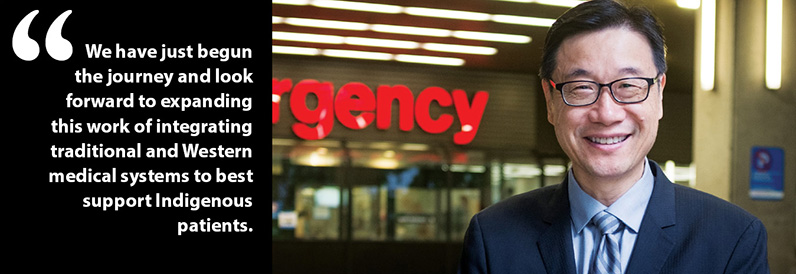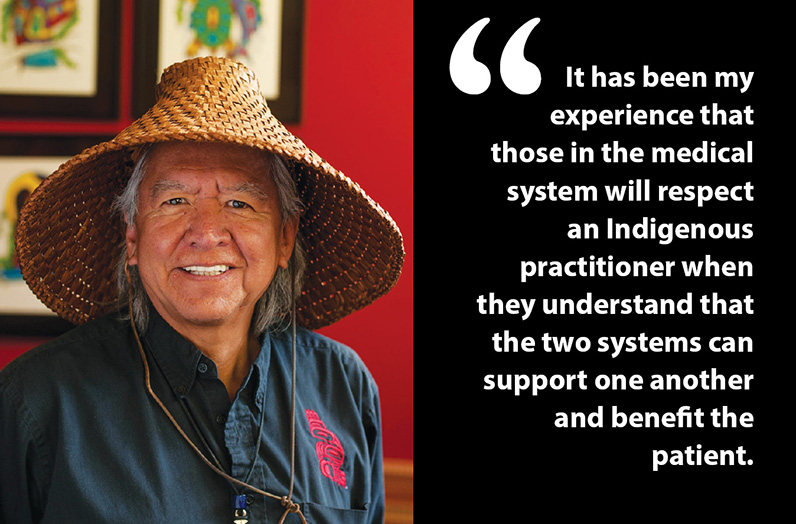Guest Editorial: In search of collaboration between Indigenous traditional practice and Western medicine
An emergency physician’s experience and a traditional practitioner’s experience.
 |
| Kendall Ho, MD, Professor, Department of Emergency Medicine, University of British Columbia. |
DR KENDALL HO: What if one day a patient asks you for therapy based on Indigenous traditional medicine? This happened to me 6 years ago when I was working in the emergency department. I saw an Indigenous patient after he had a car accident and I recommended a standard treatment plan. He politely declined and asked for Indigenous traditional medicine instead. I was unsure how to proceed as I knew very little about this approach. He thanked me and we parted company amicably. This began my journey to explore Indigenous traditional medicine and how it might be used in combination with Western medicine. Soon afterward I met Elder Gerry Oleman, who became my teacher and guide, opening my eyes to how traditional practitioners contribute to the BC medical system.
ELDER GERRY OLEMAN: In 1995 families with a loved one in hospital started to call me. When I reflect on these first calls, I think about how I had not been formally identified as someone to call in the Indigenous world when there is a medical crisis. I was called because I was known for practising Indigenous ceremony, meaning I was taught and mentored by Elders in Indigenous ways of helping those in need. Today when I am called to the hospital, I connect with the family first so I can learn what is going on with the patient. Once I have the information, I share with the family and patient what I will be doing and carry on only after obtaining their approval. Since I am working in a hospital setting, I understand that the patient is in the hands of competent medical professionals and that we should not interfere with each other’s practices. I see my involvement as providing what is missing for the patient: attention for the soul/spirit of the patient. With my words, songs, prayers, and spiritual tools I am helping to strengthen the spirit of the individual. If I accomplish this, the patient can become an active participant in the healing process. I believe that what Indigenous practitioners provide in this moment of damage to physical health can improve the mental and spiritual health of the patient. I also believe practitioners have a responsibility to assist family and friends who are present so that they can support the patient and medical staff in the healing process.
When I look at my involvement and journey working with patients, families, and health care professionals in the medical system, I see the need for all involved to understand each other’s roles and responsibilities. Working with patients and families early on, I came to appreciate the rhythm of the hospital and would plan my work around that rhythm. As a result, I have never had conflict with the system. I do not have formal recognition when I am called to the hospital, yet the Indigenous practices I offer patients are not disallowed. I have heard of Indigenous practitioners having difficulties carrying out their work of assisting patients. This may very well be because of ignorance or racism on the part of the health care staff. It has been my experience that those in the medical system will respect an Indigenous practitioner when they understand that the two systems can support one another and benefit the patient. I believe that although there are differences, when we work together and do not interfere with each other these differences can be worked out. After all, Indigenous practitioners are involved in the medical system at the request of families and patients. I am grateful to the Canadian medical system for all the services it has provided to me and my family. I am also extremely grateful to the traditional practitioners who have provided comfort, hope, and success for members of my family and for myself personally.
DR KENDALL HO: As an emergency physician, my journey with Elder Gerry Oleman and other traditional practitioners has helped me better understand the context of Indigenous patients, their caregivers, and their communities regarding a holistic approach to health and wellness, and the potential anxiety some patients may experience when seeking Western medical care. This journey raises my awareness of the need for cultural safety and positively changes my practice when I interact with Indigenous patients. My journey also challenges me to be more aware of and seek understanding from all patients I encounter and treat.
As executive director of the interCultural Online Health Network (iCON), I would like to thank the many collaborators and supporters who have been part of this journey so far to incorporate traditional healing into the BC health care system. I would like to thank the numerous Indigenous Elders and their communities and all of the BC health authorities, particularly the First Nations Health Authority, Vancouver Coastal Health, and Island Health. I would also like to thank the BC Ministry of Health for providing support through the Patients as Partners Initiative. We have just begun the journey and look forward to expanding this work of integrating traditional and Western medical systems to best support Indigenous patients. If you feel inspired by our stories, I invite you to join us on our journey to learn more and to collaborate with us.
 |
| Gerry Oleman, Elder and Traditional Practitioner, the St’at’imc Nation. |
Acknowledgments
We would like to acknowledge that the activities discussed in this issue of the BCMJ took place on the traditional unceded homelands of the xʷməθkwəy̓əm (Musqueam), Skwxwú7mesh (Squamish), Səl̓ílwətaʔ/Selilwitulh (Tsleil-Waututh) Nations, and the land of the W̱SÁNEĆ (Pauquachin, Tsartlip, Tsawout, Tseycum) peoples.

